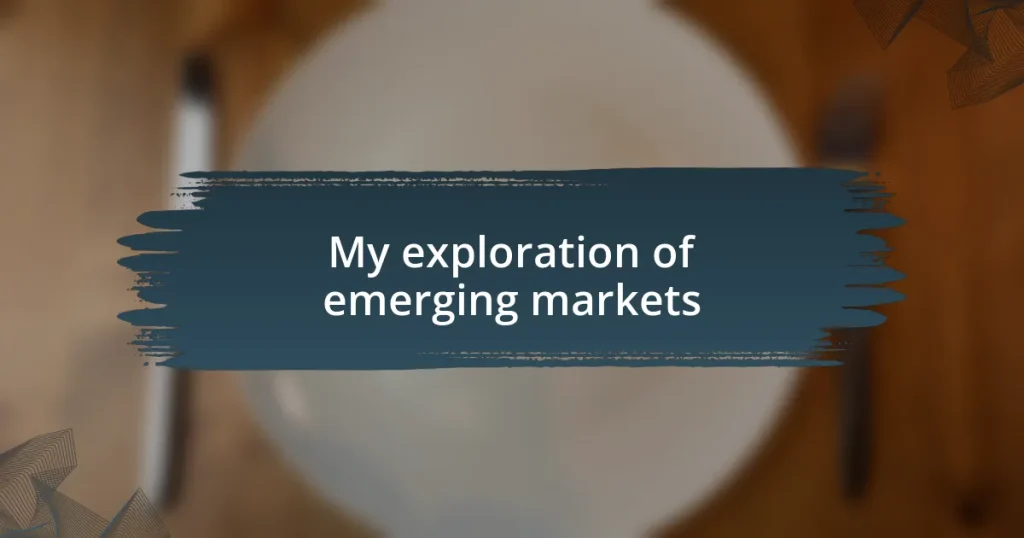Key takeaways:
- Emerging markets present significant investment opportunities driven by young populations, untapped potential, and local entrepreneurial spirit.
- Key economic indicators like GDP growth, demographic trends, and political stability are critical for evaluating emerging markets.
- Understanding cultural differences and local market dynamics is essential for navigating challenges and fostering successful investments.
- Building local partnerships can mitigate risks and create new opportunities in emerging markets.
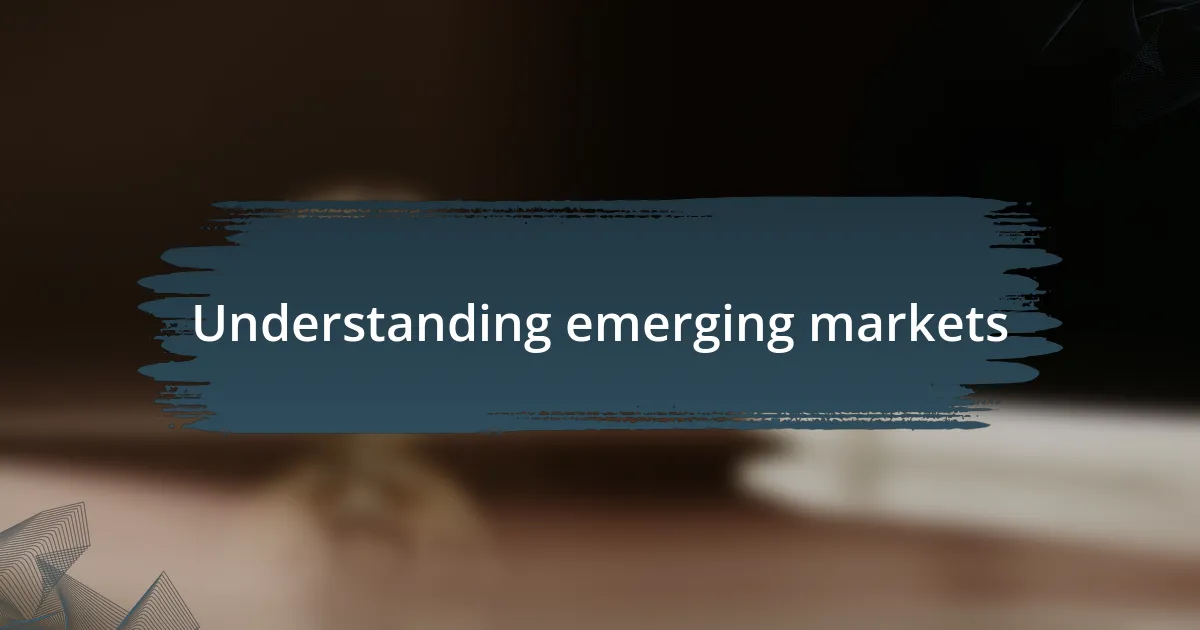
Understanding emerging markets
Emerging markets are often characterized by rapid economic growth, industrialization, and increased consumer spending, but what really draws my attention is the underlying dynamism that defines them. I remember my first visit to a thriving market in Southeast Asia; the energy was palpable. The vendors, the colors, and the chatter created an environment where innovation felt like the air itself.
Many might wonder, what makes these markets so alluring to investors? From my perspective, it’s the untapped potential—countries with young populations ready to drive demand and innovate. For instance, while engaging with local entrepreneurs, I was struck by their resilience and creativity, often overcoming challenges that seemed insurmountable. It made me think about the power of determination in shaping economies.
Another aspect that intrigues me is the diversity of opportunities. Each market is unique, influenced by its culture, politics, and geography. I recall discussions with business leaders in Latin America, where they shared their strategies for navigating local intricacies. Their insights shaped my understanding of how emerging markets aren’t just about numbers—they’re about the stories and aspirations of people driving change.
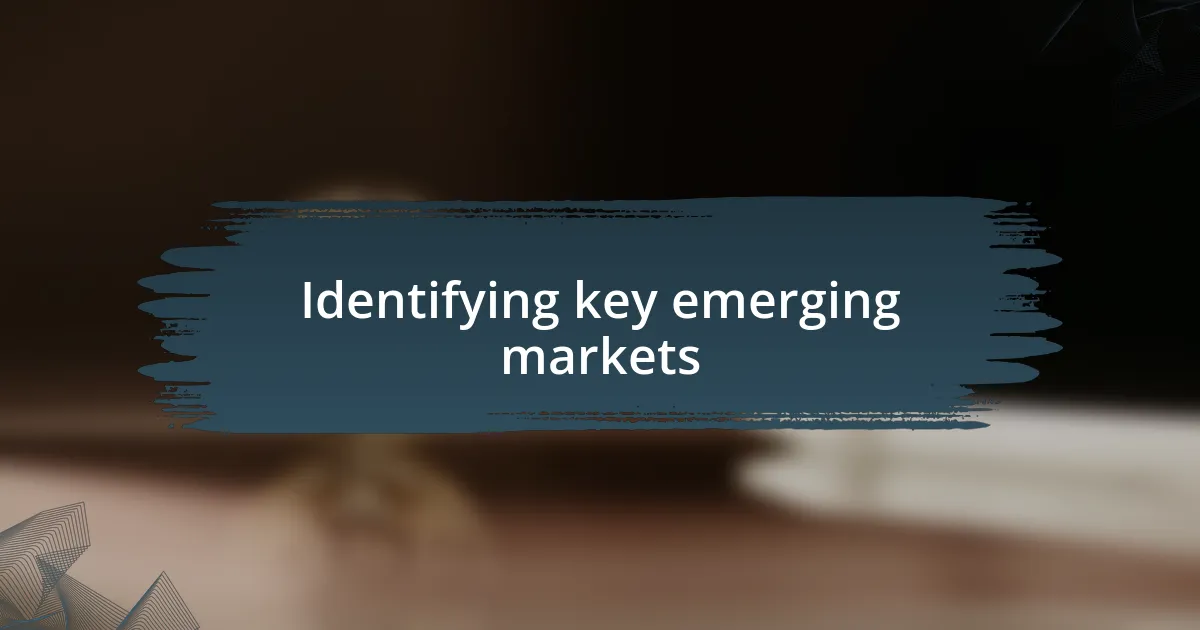
Identifying key emerging markets
Identifying key emerging markets requires a blend of economic indicators and on-the-ground insights. I remember attending a conference where data experts highlighted unexpected rising stars, like Nigeria and Vietnam. These conversations opened my eyes to markets that may not be on everyone’s radar yet possess immense potential. When sifting through statistics, I always look for populations that are not only growing but young and vibrant—this is where future demand will stem from.
Several crucial factors can help pinpoint these promising markets:
- Economic Growth Rate: Countries showing consistent GDP growth are essential to watch.
- Demographic Trends: A young, growing population indicates a future consumer base.
- Political Stability: Emerging markets with stable governance are more attractive for investment.
- Market Accessibility: Infrastructure development and technological adoption can reveal market potential.
- Natural Resources: Access to valuable resources can drive economic growth.
In my experience, it’s the combination of these elements that leads to sustainable success. For instance, when I visited Kenya, the entrepreneurial spirit was undeniable, with startups blooming in various sectors, from technology to agriculture. The local entrepreneurs I spoke with were not just optimistic; they were actively shaping their economy with innovative solutions that often felt ahead of their time.
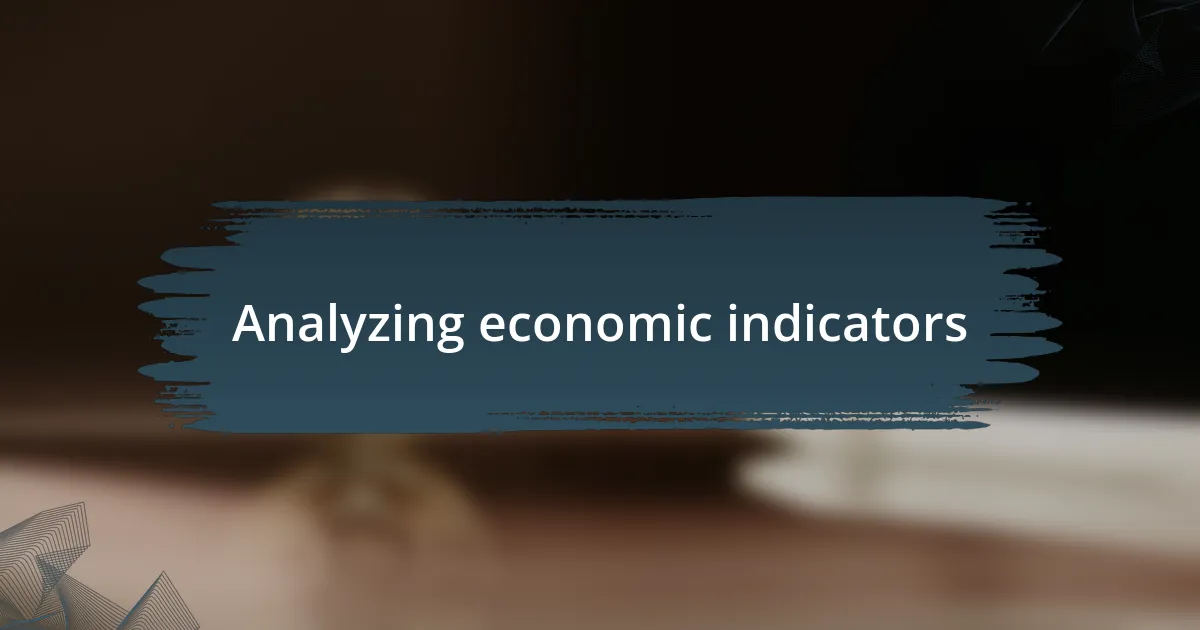
Analyzing economic indicators
Analyzing economic indicators is vital for understanding an emerging market’s potential. I have often found that looking beyond the basic numbers can reveal intricate patterns. For instance, during my trip to Brazil, I distinctly noticed the correlation between the rising middle class and the increasing consumer spending. This observation reinforced my belief that understanding social dynamics is just as important as analyzing figures like GDP growth.
It’s fascinating how various economic indicators can paint a comprehensive picture of a country’s health. I remember my discussions with local economists in India; they emphasized the importance of inflation rates and foreign investment flows. These indicators serve as critical signals of market confidence and stability, influencing my investment decisions significantly.
To make the analysis more structured, I often create tables to compare economic indicators across different markets. This practice has helped me identify trends effectively and spot lucrative opportunities. Below is a simple table highlighting some key indicators across selected emerging markets:
| Country | GDP Growth Rate (%) |
|---|---|
| Nigeria | 3.5 |
| Vietnam | 6.8 |
| Brazil | 2.0 |
| India | 7.0 |
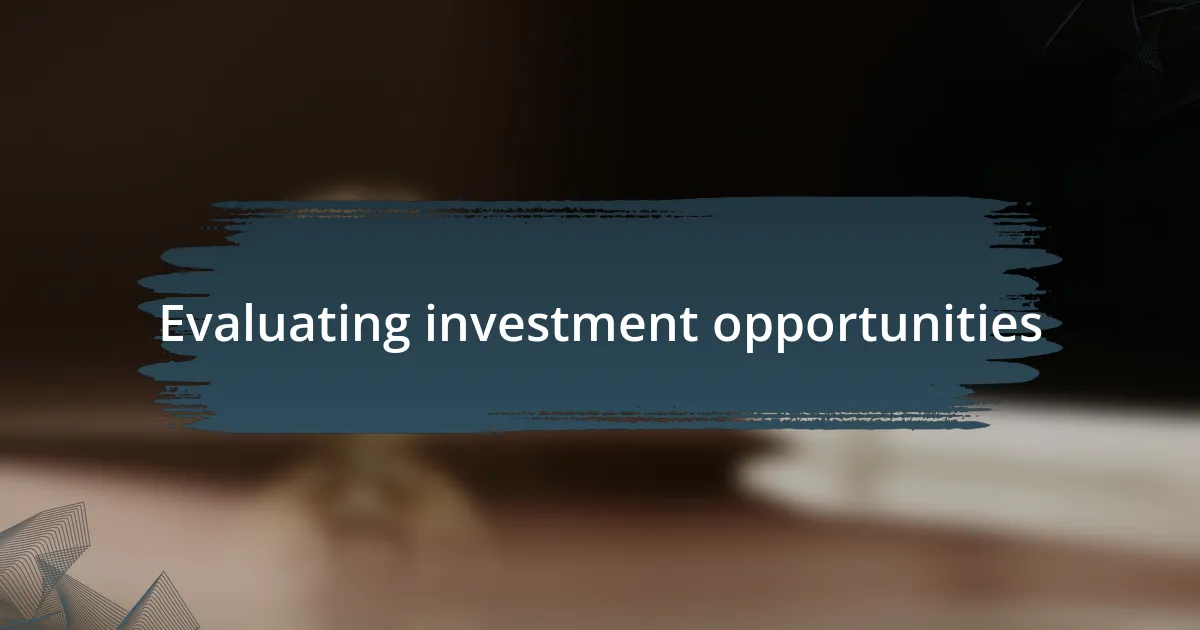
Evaluating investment opportunities
When I evaluate investment opportunities, I often reflect on the role of regulatory environments. For instance, while researching potential investments in Indonesia, I found myself grappling with the complexity of local laws. It’s crucial to understand how regulations can either facilitate or hinder business growth. How do different regulations affect your perspective on an emerging market? For me, understanding these nuances helped shape my investment strategy significantly.
Another key consideration is the technological landscape of a country. In my experience, countries with robust tech ecosystems tend to attract more investment. I vividly recall my visit to Kenya, where I witnessed the rise of mobile banking solutions. This innovation created a ripple effect, driving economic growth in sectors I’d never considered before. It’s a powerful reminder that sometimes, the most exciting opportunities lie at the intersection of technology and traditional markets.
Lastly, I always keep an eye on geopolitical stability when evaluating an investment. My travels to Latin America taught me how quickly things can change. For example, I was once in a country poised for growth but faced sudden political unrest. This experience taught me that even a market with favorable indicators can become risky overnight. How do you assess risk in your investment decisions? Personally, I find that staying informed and flexible is key in navigating such uncertainties.
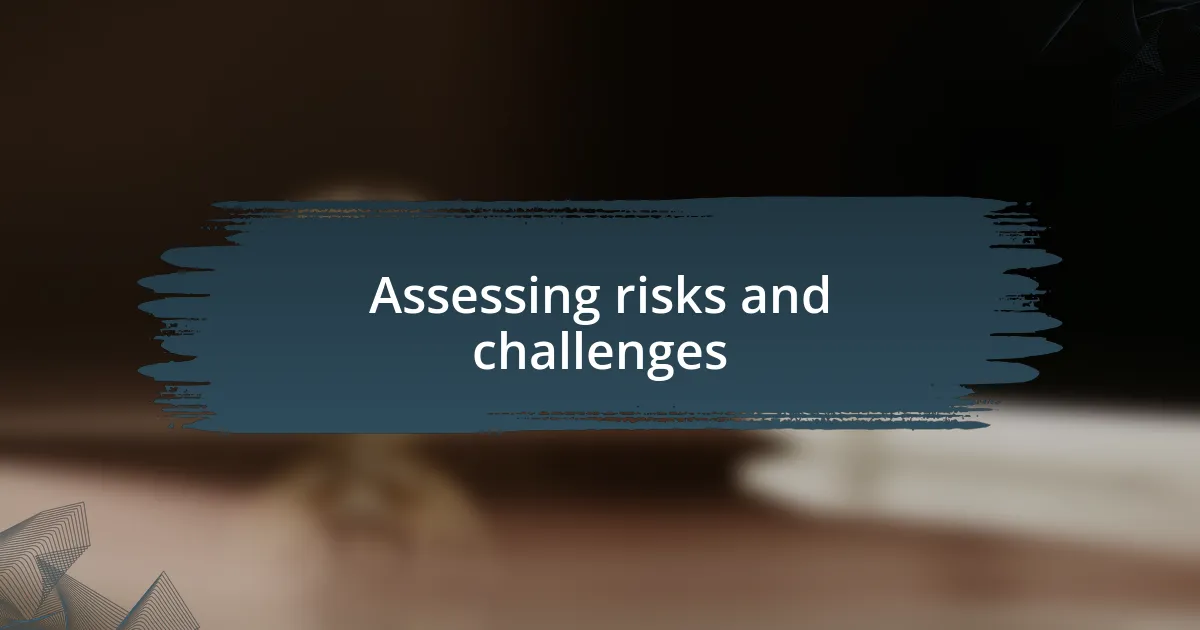
Assessing risks and challenges
When I assess risks in emerging markets, I often think about the economic volatility that can catch investors off guard. I remember sitting in a café in Venezuela a few years back, where inflating prices changed daily. That experience heightened my awareness of how inflation rates and currency fluctuations can erode potential profits. Have you ever felt that uncertainty in your own investments? It can be daunting.
Additionally, evaluating the local market dynamics is crucial. During my time in India, I observed how cultural factors influence consumer behavior significantly. One particular instance that stood out was a failed product launch due to a misunderstanding of regional preferences. It made me realize that what works in one area might not translate elsewhere, emphasizing the need for deep market research. How well do you know your target audience?
Finally, I can’t stress enough the importance of local partnerships when entering emerging markets. I’ve had firsthand experiences where collaborating with local businesses not only mitigated risks but also opened doors to opportunities I hadn’t considered. In one case, a partnership in Nigeria allowed me to navigate regulatory hurdles effectively. Isn’t it fascinating how the right alliances can change the game entirely? These relationships are often the safety net that can make or break an investment strategy.
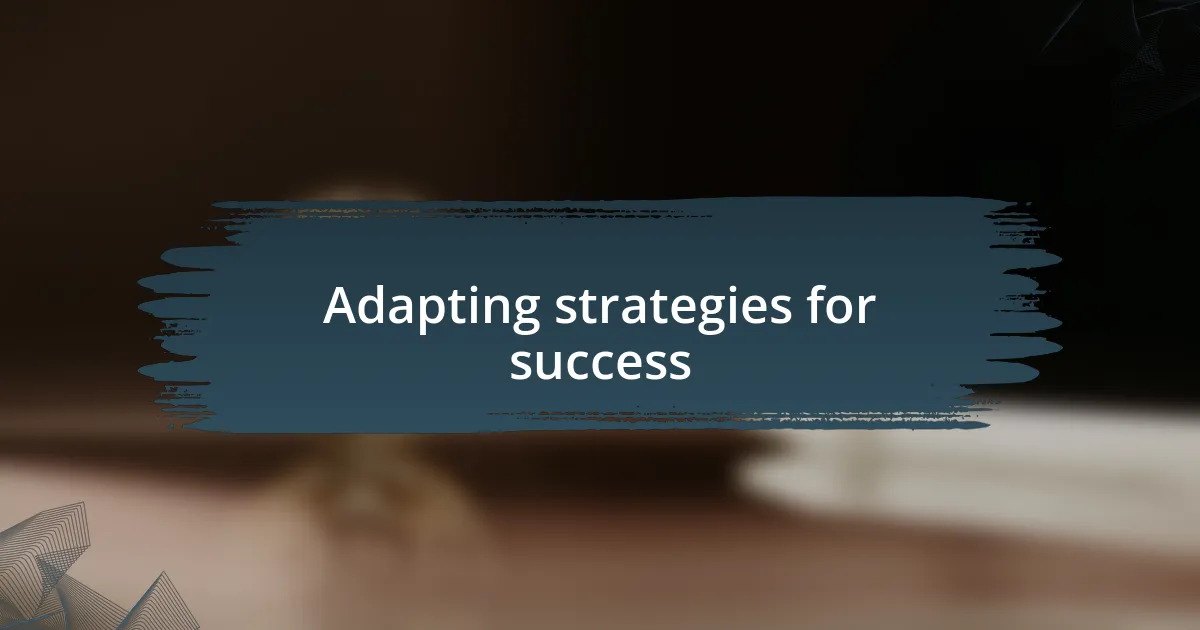
Adapting strategies for success
Adapting strategies for success requires a keen understanding of the local landscape. I vividly recall my time in Brazil, where adjusting my marketing approach to fit regional cultural nuances was crucial. It was like decoding a puzzle; when I incorporated local traditions into my campaigns, I saw a remarkable increase in engagement. Have you ever experienced the power of local relevance in your endeavors?
Moreover, flexibility is essential in shaping strategies that resonate. During a project in Southeast Asia, I faced unexpected regulatory changes. Instead of sticking rigidly to my original plan, I pivoted quickly, leveraging the insights from local stakeholders. Adapting on the fly not only preserved my investment but also built trust with the community. Isn’t it interesting how adaptability can transform challenges into advantages?
Lastly, monitoring and evaluating your strategies continually is key. I learned this lesson the hard way in a project in Eastern Europe, where initial success was followed by stagnation. By conducting regular reviews and seeking feedback, I adjusted my approach and set it on a path of renewed growth. Have you embedded a feedback loop in your strategies? It can be a game-changer, ensuring you stay responsive and relevant in fast-paced environments.
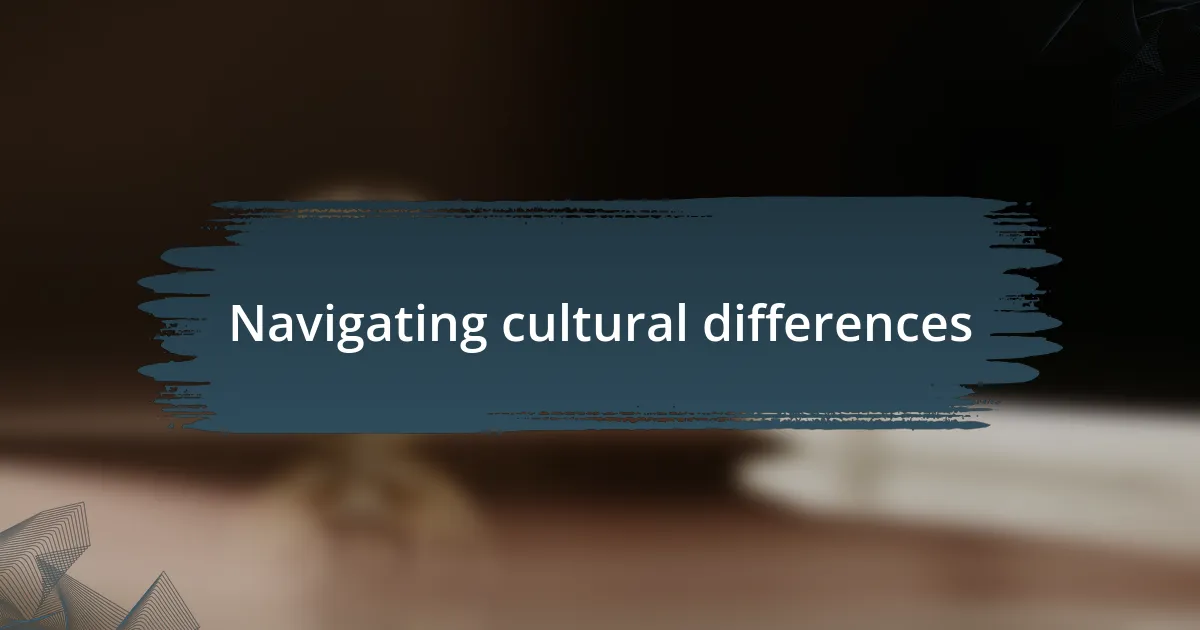
Navigating cultural differences
Understanding cultural differences is essential when venturing into emerging markets. I remember working in India, where my assumptions about business etiquette were quickly challenged. I was struck by how a simple handshake was replaced by a warm greeting and a slight bow, underscoring the importance of respect and familiarity. Have you ever felt the weight of a cultural norm that was entirely new to you?
Diving deeper, I realized that language plays a critical role in bridging these cultural gaps. In a project in Nigeria, despite speaking English, I noticed that using local dialects helped convey my dedication and respect for the people’s heritage. It wasn’t merely about communication; it was about connection. Have you considered how language can create bonds that transcend mere words?
Navigating these cultural differences often requires patience and openness to learning. In a team meeting in Vietnam, I found myself overwhelmed by the indirect communication style, where agreement was often subtle and not always explicit. Rather than viewing this as a barrier, I embraced it as a unique way of fostering deeper collaboration. Isn’t it fascinating how understanding these nuances can lead to richer relationships and successful outcomes?











